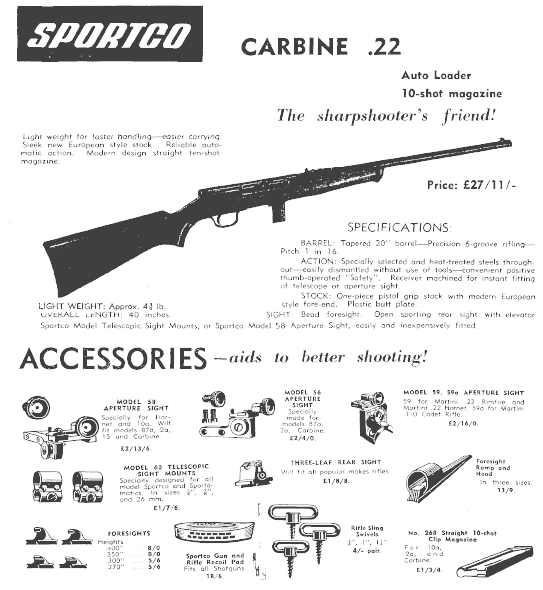L29A1 and L29A2 .22RF Sportco Model 71S Rifles
and the former's training employment with the Chieftain Tank
The Australian manufactured Sportco 71S has enjoyed an unusual and interesting life with British Forces.
First opened in Adelaide in 1947, the Sporting Arms Company Ltd., initially produced the Sportco single-shot .22 rimfire Martini rifles
converted from those ubiquitous imported Martini Cadet rifles, many of which continue to this day to faithfully serve Antipodean shooters.
Sportco followed up with their own semi-automatic .22 rifles, full-bore models and shotguns until closure ca. 1980.
The company provided the British military with this blow-back action .22RF self-loading training rifle with a ten round magazine capacity, wholly manufactured by Sportco. Twin extractors gave the rifle reliable actioning.
Its original Sportco designation was the Model 71S, and the rifle was marketed commercially in its homeland.
With a 24" 4-groove barrel, a 42" O/A length, and of 6lbs weight, it was adopted by the British government for special use in weapons training,
when it was afforded the nomenclature " Rifle, L29A2', preceding the 5.56mm L98A1 Cadet Rifle.
The example of this .22 rimfire arm shown on this page is to be found in the Enfield Pattern Room collection, now domiciled at the Leeds Royal Armouries Museum.
All images on this page are joint copyright to www.rifleman.org.uk and the Royal Armouries.

Above and below: the Sportco 71S - alias in UK service rifle nomenclature - L29A2 - used for automatic weapons training prior to the L98A1

The "gilled" machining of the receiver is reminiscent of that of the Savage Model 6A semi-automatic .22 rifle, the appearance of which rendered that rifle something of an aesthetic classic.
This latter rifle was, strangely, also employed by British forces as a sub-calibre weapon, see the Savage Model 6A as a sub-calibre attachment for the Boys Anti-tank Rifle.
Both the Sportco and Savage semi-auto rimfire rifles have been well thought of in sporting circles for many years.

The barrel markings will be familiar to any who have owned or shot these rifles in the past.

The rear-sight has the semblance of a design used on BSA Sportsman irfles for many years.

The cocking-lever viewed from above

and the action and magazine seen from the right-hand "business" side.

The underside is shown below, with the trigger-guard, magazine, plus the action bedding-screw forward of the magzine-well.
Note the unusual use of cross-head "Phillips" type screws, also to be seen on the Canadian Mossberg 43M-B rifles.

The magazine is here shown from above, illustrating the rather unusual plan-form with a near cylindrical forward shaping.

The story so far has been somewhat reversed in timeline, as the L29A1 preceded the introduction of the L29A2 by some time.
The L29A1 came about in rather unusual circumstances. In the late 1960s, the Royal Armoured Corps were in need of a sub-calibre training system for the Chieftain tank. Early in that decade a commercial semi-automatic Sportco .22 rifle had been purchased privately by the Corps.
In 1967, the cost of a 71S in its home market was Au $51.00, and had increased by 14% in 1970, when the exchange rate was close to two dollars to the pound.
An contemporary U.K. advertisement for the similar Sportco .22 "Carbine ((with a 20 inch barrel) is illustrated below.

Whilst planning the development of the sub-calibre equipment, seven or eight years later, this rifle was deemed suitable for the purpose by the F.V.R.D.E. - the Fighting Vehicle Research & Development Establishment.
A bracket was designed to mount the rifle on a Chieftain (FV 4201) tank for field miniature range use; economy and convenience of fire training being the objects of the excercise. The bracket was given the nomenclature No.6 Mark 1.

After what was then described in a memorandum as "considerable confusion", a number of rifles were subsequently purchased in already stripped form with reduced furniture, and, prior to acceptance for sub-calibre use, the rifle was afforded the L29A1 nomenclature and the equipments were put to use.
The ".22-IN RIFLE BRACKET FOR MINIATURE RANGE TRAINING" was written up in an acceptance brochure in June 1968.
A scrollable and searchable flip-page booklet of the document is illustrated below.
This document may take a few moments to load.